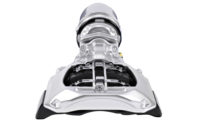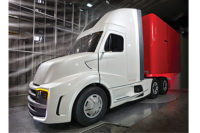Mid-America Trucking Show 2013 post-show report
Trucking trade show highlights refined product lines.

Continental’s 360 Degree Camera Surround System provides commercial vehicle drivers with 3-D bird’s-eye, all-around views of their vehicles at a single glance. (Image courtesy of Continental Commercial Vehicles & Aftermarket)

The Spicer EconoTrek tandem axle for six-by-two tractor configurations improves fuel economy by up to 3 percent and reduces weight by up to 400 pounds when compared with a traditional 40,000-pound tandem axle arrangement. (Image courtesy of Dana Holding Corp.)

Kenworth Truck Co. showcased its Kenworth Medium Duty Cabovers, which provide maneuverability and durability. (Image courtesy of Kenworth Truck Co.)

Ideal for regional hauling, the Mack Pinnacle is equipped with the Cummins Westport ISX12 G engine and is available for order with either a liquid natural gas or compressed natural gas fuel system. (Image courtesy of Mack Trucks Inc.)

Cummins and Peterbilt recently released test results showing that their demonstration tractor-trailer has achieved a 54 percent increase in fuel economy, averaging nearly 10 mpg under real-world driving conditions. (Image courtesy of Cummins Inc.)

Volvo’s D13 liquid natural gas engine, which will be available for order during the second half of 2014, delivers diesel-like durability and performance. (Image courtesy of Volvo Trucks)






Each year in March, the trucking industry comes together in Louisville, Ky., for its single largest event, the Mid-America Trucking Show (MATS). As the industry’s key event, it’s fairly common for the chief executive officers of exhibiting companies to report on recent performance and prognosticate about the year to come.
After returning to a relatively normal production level of roughly 250,000 Class 8 trucks (the industry’s bellwether) in 2012, the consensus opinion from the executives is for production to be off slightly, with estimates of between 210,000 and 240,000 units to be sold in 2013.
Although these numbers are overwhelmingly positive for truck makers — they represent a return to normal sales levels — they do not make up for a drop in unit sales of roughly 250,000 during the tough times of 2009-2010.
Presuming the business will see a full recovery and a return to normal replacement cycles a few years from now, there is a huge level of pent-up demand in place that will tip the new-truck sales business heavily toward a seller’s market when the economic pendulum eventually swings. At that point, savvy fleet operators won’t want to be caught with a geriatric fleet and new truck order lead times stretching into 18 months or more.
Given the market gyrations between 2004 and 2011, the industry is cautiously approaching the potential for recovery. This was evident in the type and tone of product announcements made at this year’s show.
Rather than showcasing the typical plethora of new models and components seen before the recent slump, this year’s new product announcements were balanced, and perhaps even overshadowed, with news of existing product lines being refined to meet impending regulatory changes and to help fleets remain profitable in a turbulent economy.
Here’s a look at the highlights from the show:
Continental Commercial Vehicles & Aftermarket, Allentown, Pa., (conti-online.com) introduced its
360 Degree Camera Surround System, which is designed to provide drivers with 2-D and 3-D bird’s-eye views of their vehicles while also delivering all-around views of the vehicles at a single glance.
The 360-degree monitoring system improves driving and safety in critical situations, such as dense city traffic, narrow loading ramps, and busy warehouse yards by providing improved information and data exchange between the driver, vehicle and infrastructure. It also can be permanently active when the vehicle is standing still, allowing the driver to monitor the vehicle and its cargo.
The camera-based assistance system also enhances vehicle operation efficiency by reducing maneuvering time and vehicle damage risk, as well as potential downtime and repair costs. It helps the driver to better see wall projections, objects in blind spots, corners of buildings, and other vehicles in order to operate the vehicle safely, the company says.
The driver can choose between two display modes — a 2-D or 3-D view — with the push of a button. The 2-D mode focuses on the driver’s immediate surroundings, while the 3-D mode displays relations and elevations of the surroundings and makes other road users more recognizable. The driver also has the ability to control specific, individual cameras to view a more precise area in difficult driving situations.
The new system consists of four micro-cameras with fisheye lenses mounted on the outside of the vehicle that provide a high-resolution sweep of the sides, rear and front of the vehicle. An electronic control module merges these high-resolution images on display in the cockpit, giving the driver a bird’s-eye view of the vehicle and different angles in real time.
Dana Holding Corp., Maumee, Ohio, (dana.com) introduced the Spicer EconoTrek tandem axle, a new lightweight six-by-two axle configuration that improves performance, reduces maintenance and increases fuel economy for heavy-duty tractors.
The EconoTrek tandem axle package combines the company’s newly upgraded Spicer S170 and S190 single-reduction, single-drive axles with the new Spicer S20-045B tag axle. For users who can benefit from the advantages offered by a six-by-two configuration, the EconoTrek improves fuel economy by as much as 3 percent through decreases in mechanical drivetrain energy loss and reduces weight by as much as 400 pounds when compared with a traditional 40,000-pound tandem axle arrangement, the company says.
The Spicer EconoTrek tandem axle is optimized for use with electronic-controlled air suspension systems, such as the new Bendix eTrac system. The eTrac system will seamlessly transfer weight to the drive axle for improved low-speed traction when combined with Spicer’s wheel-differential lock feature, it adds.
Kenworth Truck Co., a company of Paccar Inc., Bellevue, Wash., (kenworth.com) showcased its Kenworth Medium Duty Cabovers, which provide maneuverability and durability. Available with wheelbases ranging from 142 to 242 inches, Kenworth’s K270 and K370 cabover models can accommodate bodies from 16 to 28 feet, the company says. Both the K270 and K370 are powered by a 6.7-liter Paccar PX-7 engine with a standard 220 horsepower rating and
520 pound-feet of maximum torque.
Optional ratings range up to 250 horsepower with 660 pound-feet of torque. Both models are available with Allison five-speed transmissions. Inside, the truck accommodates bench seating for three. Its 2,500-square-inch wraparound windshield combines with large side windows to give optimum visibility, the company says.
“Beverage distributors, pick-up and delivery, food processors and other urban delivery applications have been among the early customers of the K270 and K370 medium-duty cabovers,” says Kenworth Marketing Manager Doug Powell. “This year, we expect our cabover sales to increase further. We expect to see customers that run lighter trucks move to longer-lasting trucks with components designed to stand the test of time. The K270 and K370 will lower the total cost of ownership.”
Kenworth also introduced the Bendix eTrac Air-Bag Transfer System for six-by-two configuration air suspensions on select models of Kenworth Class 8 trucks. The Bendix eTrac system will be available on Kenworth’s T660, T680, T800 and W900 models beginning this month.
The tandem drive axle on a six-by-two configured truck has no inter-axle driveline or rear differential. Because of that, it has fewer gears and, as a result, weighs several hundred pounds lighter and experiences fewer parasitic losses for improved fuel economy. The combination of a six-by-two tandem axle configuration and wide-base tires can provide a fuel economy improvement, which will vary depending on use, road conditions and other factors.
“With one ‘live’ drive axle, trucks with six-by-two configurations can offer significant weight savings as well as fuel economy improvements over that of a truck with a traditional six-by-four configuration,” says Kenworth Chief Engineer Kevin Baney.
Baney adds: “The eTrac system links into the Bendix ABS braking system with automatic traction control (ATC) and electronic stability programming. This system automatically engages and disengages — without driver input — the vehicle’s air suspension pressure transfer system, transferring pressure from the non-drive to the drive axle when it recognizes wheel slip. This provides improved fuel efficiency in a lighter package combined with on-demand traction.”
The Bendix eTrac system protects the drivetrain by automatically disengaging after a low-traction event or when the vehicle’s resumed speed exceeds 25 mph. The system also allows for manual activation at speeds below 10 mph or when a vehicle’s ATC mud/snow switch is enabled.
Kenworth also now is offering its T680 and T880 models, optimized with the Paccar MX-13 engine, in a configuration for superior maneuverability, visibility and performance, it says.
“Under this new offering, the bumper to back-of-cab measurement (BBC) is 6 inches less than the standard BBC configuration for the T680 and T880,” Baney says. “As a result, there’s enhanced visibility and a tighter turning radius with improved maneuverability. Plus, the T680 and T880 provide overall better performance when fully optimized with the 12.9-liter Paccar MX-13 engine.”
The Kenworth T680 is available for the first time in a 119-inch BBC. This configuration includes a three-piece, bonded, aerodynamic hood made of sheet molding compound (SMC), a lightweight, durable composite material with an excellent finished surface. SMC not only makes the T680 hood robust but also gives it a high paint quality, the company says. The T680 also is offered in a 125-inch BBC standard length with a three-piece SMC hood.
The Kenworth T880 is available in a 116.5-inch BBC configuration, which includes a new, five-piece hood made of Metton, which is a lightweight, durable composite material with excellent impact resistance and a finished surface. The T880 also is available in a 122.5-inch BBC standard length with a five-piece Metton hood. Both hoods have bolted-on fenders to provide great serviceability and quick replacement.
Greensboro, N.C.-based Mack Trucks Inc. (macktrucks.com) unveiled its 12-liter natural gas powered Pinnacle tractor, offering a liquefied natural gas (LNG) solution for highway applications. The initial production model was built for Atlanta-based UPS. The addition of the LNG Pinnacle expands the company’s natural gas lineup to the highway segment. Mack already offers natural gas-powered TerraPro refuse models.
“By expanding the UPS natural gas fleet, we have an opportunity to take advantage of a domestic resource, a domestic product, and continue our sustainability efforts,” says Mike Britt, director of alternative fuel vehicle engineering at UPS. “Supporting the overall growth of LNG infrastructure ultimately benefits our customers and community by reducing greenhouse gas emissions.”
Ideal for regional and distribution applications, the Pinnacle is equipped with the Cummins Westport ISX12 G engine and is available for order with either an LNG or compressed natural gas (CNG) fuel system. The maintenance-free after treatment, requiring only a three-way catalyst to meet Environmental Protection Agency (EPA) 2010 and California Air Resources Board (CARB) emissions standards, combined with low-cost natural gas, reduces vehicle lifecycle costs and improves return on investment, the company says.
Columbus, Ind.-based Cummins Inc. and Peterbilt Motors Co., a Paccar company, (cummins.com and peterbilt.com) released test results showing that their demonstration tractor-trailer has achieved a 54 percent increase in fuel economy, averaging nearly 10 mpg under traditional driving conditions.
The “SuperTruck” developed by the two companies features a higher-efficiency engine and an aerodynamic tractor-trailer that significantly reduces drag. The truck also includes a system that converts exhaust heat into power delivered to the crankshaft, electronic controls that use route information to optimize fuel use, tires with lower rolling resistance, and lighter-weight material throughout.
The Class 8 Peterbilt 587 truck, powered by a Cummins ISX15 engine, averaged 9.9 mpg during testing last fall on U.S. Route 287 between Fort Worth and Vernon, Texas. The testing was conducted across 11 runs meeting Society of Automotive Engineers (SAE) International test standards along a 312-mile route.
The tractor-trailer had a combined gross weight of 65,000 pounds. Similar trucks typically achieve between 5.5 and 6.5 mpg, the company says. The 54 percent increase in fuel economy would save approximately $25,000 annually based on today’s diesel fuel prices for a truck traveling 120,000 miles a year, it adds.
Peterbilt also announced the availability of its new 2013 Cummins Westport ISX12 G natural gas engine. Since 1996, Peterbilt has been manufacturing trucks featuring LNG and CNG fuel system solutions for over-the-road, regional and vocational applications.
“With growing demand for natural gas engines, we are pleased to add the Cummins ISX12 G to our natural gas lineup,” says Peterbilt General Manager Bill Kozek. “The dedicated natural gas engine provides customers exceptional fuel economy with an environmentally friendly, domestically sourced fuel that helps lower operating costs.”
Based on the Cummins ISX12 diesel engine, the ISX12 G is both EPA and CARB certified. The ISX12 G will not require a diesel particulate filter or a selective catalytic reduction system. Available in August, the new ISX12 G engine features spark ignition technology and a three-way catalyst, with ratings up to 400 horsepower and 1,450 pound-feet of torque.
Volvo Trucks, a company of The Volvo Group, Gothenburg, Sweden, (volvotrucks.com) showcased the prototype D13-LNG engine, its first integrated natural gas solution for the North American market. The Volvo D13-LNG compression-ignition engine utilizes LNG to deliver increased range and significant fuel efficiency improvements compared with other natural gas-powered offerings. Customers also will be able to specify a Volvo I-Shift automated manual transmission with the LNG engine.
The Volvo 13-liter compression-ignition engine, which utilizes a small amount of diesel fuel to ignite the LNG, delivers diesel-like durability and performance in terms of horsepower and torque. The D13-LNG also provides about a 20 percent fuel efficiency improvement compared with spark-ignition natural gas engines and an even greater fuel cost reduction when compared with diesel-powered engines. Volvo’s VNL daycabs, powered by the Volvo D13-LNG engine, will be available for order during the second half of 2014.
Chicago-based Great Dane (greatdanetrailers.com) featured The Great Dane Innovation Experience, which included three hands-on exhibits of the company’s most advanced, innovative products, all designed to further enhance and extend trailer performance and lifespan. Among the innovations showcased were Great Dane’s exclusive CorroGuard anticorrosion coating, its newest EnduroGuard rear-frame assembly, and its ThermoGuard reefer liner package.
Highlighted on four of the company’s redesigned trailers were a range of standard features such as the Stemco Platinum Performance Plus Wheel End System with an exclusive six-year limited warranty and Grote’s Long-Life Light System with 100-percent LED MicroNova Dot lamps, dual-intensity high-mount stop lights, and a fully sealed modular wiring harness covered by a 10-year warranty.
Following a year of real-world testing with commercial truck fleets across the United States, Continental Tire the Americas LLC, Fort Mill, S.C., (continentaltire.com) kicked off sales of its ContiPressureCheck system. The system utilizes sensors mounted inside the tires to provide accurate temperature and pressure readings. The system can be used for tractors, trailers or both.
The ContiPressureCheck system saves drivers and fleets both time and money by alerting the driver in-cab of sudden inflation deviations as well as slow air losses to the tires, the company says. By correcting these issues before the tires require replacement, fleets and drivers can prevent vehicle downtime, extend the tread life of their tires, and protect their valuable casing investment. Proper tire inflation also reduces rolling resistance of the tire and, in turn, fuel consumption.
The company also launched its all-new Conti Hybrid HD3 tire, which offers the drive-tire trifecta of mileage, fuel efficiency and traction.
Fleets today require not only advanced technology but the ability to utilize the same tire whether they are operating in long-haul or regional applications, said Alex Chmiel, Continental Tire brand and communications manager.
“We listened when our customers told us they needed fuel efficiency when they are on the highway and the durability and extended mileage when they’re on regional roads,” he said in a statement. “The new Conti Hybrid HD3 addresses the needs of this evolving segment in order to provide the best of both worlds from one all-new truck tire.”
The Conti Hybrid HD3 now is Continental’s widest dual drive tire at 248 mm with 27/32-inch tread depth in a new regenerating pattern that is cut in three dimensions. The combination of these characteristics and a large tread volume allows for long tread life as well as a larger footprint that provides excellent traction when operated on highways.
The traction requirements for regional traffic, which often include changing weather conditions and curved roads, also have been addressed in the HD3’s tread geometry to provide grip throughout the life of the product. The 3-D lateral sipes and a directional tread pattern provide more gripping edges on the road surface than a traditional drive tire. These sipes also support the tread blocks against forces from the drivetrain, retarder and wheel brake system to achieve the best possible traction and braking force transfer. An open shoulder also gives ideal grip and directional control for this application.
With advanced tread cap compounding, a self-stabilizing rib-block pattern, and minimized tread deformation from a stiff shoulder, drivers can expect more than 10 percent improvement in rolling resistance against Continental’s HDR2 and HDL2 DL tires, the company says.
Looking for a reprint of this article?
From high-res PDFs to custom plaques, order your copy today!













